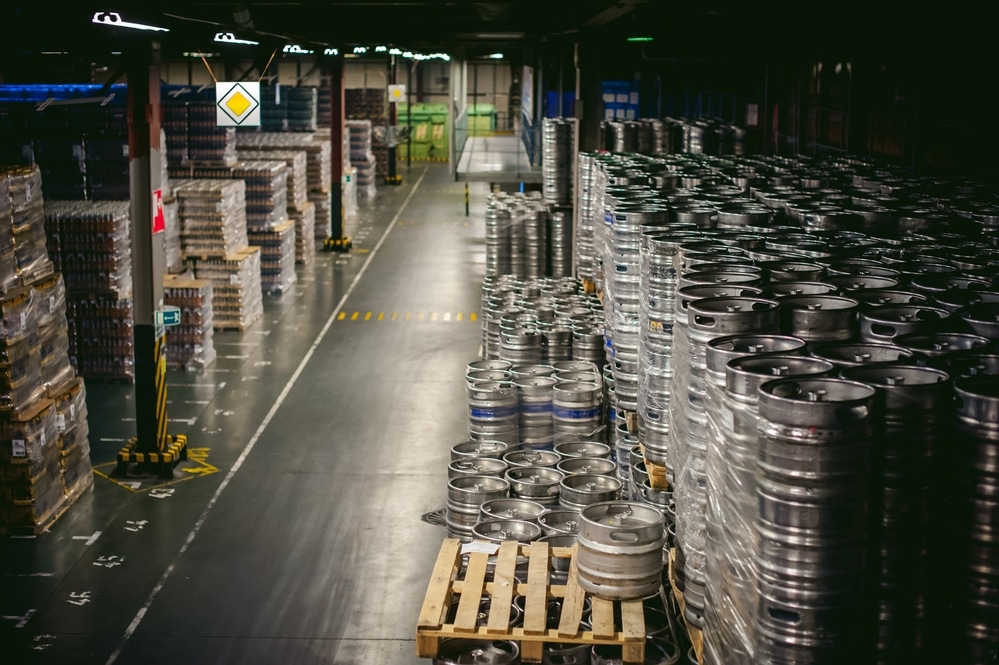 In the traditional three-tier system, the brewery makes the beer, the distributor delivers it to retailers, and the retailer sells it to the end consumer.
In the traditional three-tier system, the brewery makes the beer, the distributor delivers it to retailers, and the retailer sells it to the end consumer.
The system is compartmentalized, with each business having clearly defined roles and responsibilities.
Brewbound.com recently published this article on their site and it is re-printed here for your information.
However, with the surge in new breweries, and additional pressures on the traditional distribution system, these traditions are changing. More and more, craft breweries are exploring the option to self-distribute their own beer.
While self-distribution may be a good option for breweries, there are many issues to consider. This article will deconstruct the system of self-distribution and examine each component individually:
- State rules on self-distribution
- Lessons from a successful self-distributing brewery
- Start-up Capital required
- Delivery account building basics
- Margins, cash flow and costs
- Succession planning
The information may be useful for a brewery considering self-distribution, or one that is looking to fine tune their current process. As with any big project, it helps to break the problems into small, manageable pieces. The first step is to determine where self-distribution is allowed by state law.
Where is self-distribution legal?
Thanks to the 21st amendment, virtually every state has different laws regulating the sale and distribution of alcohol. According to the Brewer’s Association website, there are 35 states that allow some form of self-distribution by breweries. In the other 15 states, self-distribution is prohibited by law.
In states where self-distribution is allowed, the state may impose restrictions on how much beer can be distributed. Arizona, for example, allows self-distribution of up to 3,000 barrels, while Colorado allows up to 300,000 gallons per year.
The state may also require that the brewery be of a certain size in order to self-distribute. For example, New Hampshire allows self-distribution of up to 5,000 barrels, but only if the brewery produces 15,000 barrels or less. North Carolina only allows self-distribution for breweries under 25,000 barrels per year.
The Brewer’s Association keeps an updated listing of rules and guidelines for every state. To see if your state allows self-distribution and for more details on state rules check out https://www.brewersassociation.org/government-affairs/laws/self-distribution-laws/
Who is doing it well?
Night Shift Brewing in Everett, MA has used the self-distribution strategy to build their brands, increase volume and diversify their business.
Night Shift began brewing operations in 2012. That year they produced 200 barrels and this year they expect to do 20,000 barrels. Rob Burns, one of the brewery founders credits self-distribution for their tremendous growth.
“For us, self-distribution provides 100% focus,” Rob told me in a recent interview. “We can sell deeper into the accounts we service.”
Night Shift’s keys to success were to stay as urban as possible, and close to Boston where they get higher sell-through with accounts. They also setup the self-distribution operation as a separate business entity. This provides for separate financial reporting to track the self-distribution operation, and focus on the different aspects of running a delivery business.
There were several factors that led to the decision to self-distribute, and each is instructive for a brewery considering this option. According to Rob Burns:
- They weren’t industry guys, so they felt it was important to learn about the distribution business and operations.
- The brewery was tiny, and they needed the margin. They couldn’t afford to give away anything.
- They were nervous about the franchise laws, and being tied in for life with a distributor.
- At the beginning, they didn’t know what the business was going to be. They were thankful they didn’t sign with a distributor back then because the business has radically changed.
Despite the benefits that self-distribution has provided for Night Shift, Rob cautions that there are many factors to be aware of before jumping in.
“People think distribution is an easy 30 points, but it’s not. Distribution is a grind. There’s time, trucks, gas. 30% is not that much when you build in all the costs.”
However, in the final analysis self-distribution was the right decision for Night Shift. It allowed them to control where beer was placed and how much focus was given to their products. It was a key factor in sales growth.
“My advice to brewers,” says Rob, “is that I tell them to self-distribute first and understand the challenges: hauling kegs up flights of stairs, getting parking tickets, getting in accidents. When they are ready to find a distributor, this sets up proper expectations.”
Advantages and Disadvantages of Self-Distribution
One clear advantage of self-distribution is that the craft brewery gets to keep the gross profit that would otherwise go to the distributor. The gross profit, the difference between the selling price and cost of the product, usually ranges between 25% and 30% of sales.
Freedom and control are also advantages of a self-distribution model. The brewery can distribute where they want, with a singular focus on their products. This eliminates the concern about lack of focus from a distributor, or getting lost in a large portfolio of other brands.
A good understanding of how distribution works can provide a big advantage to a brewery when negotiating a future distributor contract. As Rob Burns notes, “I encourage them to do it to understand.” The business education gained by self-distributing provides deeper insights into the market, customer base, and the three tier system.
One of the biggest advantages of self-distribution is the opportunity to build a valuable business that can be sold. Distributors create value in their business by growing their customer base and brand portfolio. These assets are highly coveted and, if built properly, hold tremendous value. By self-distributing, the brewery can create these assets for themselves.
The disadvantages of self-distribution are less obvious at first, but become painfully clear once entering the self-distribution game in earnest. Startup costs and barriers to entry can be significant. There are trucks, equipment and warehouse space to consider. The method to pay for these costs – by lease or by purchase – will influence the financial results of the operation.
Beer distribution can be a difficult and unglamorous job. The operation involves loading trucks at the warehouse, driving to retail accounts for delivery, and unloading the product. Many retail accounts – particularly bars and restaurants – have difficult locations for receipt of delivery. Many times, drivers have to navigate narrow passageways and rickety stair cases to get the kegs where they need to go. Rain, sleet or snow, the beer must be delivered.
Another disadvantage to self-distribution is competition from established distributors. As a new self-distributor, the brewery will be challenged to simply get product placed at retail. This is no small task given the limited shelf and cooler space, and ever-increasing number of beer brands.
Placements at retail are difficult because existing distributors have already secured space due to their long-standing relationships with the accounts. In most instances, the traditional distributor has been in business for decades and is well established as a trusted and reliable business partner. The space is theirs to lose.
Distributors have to deal with hundreds of retail customers, and their various needs, demands, and idiosyncrasies. In a traditional brewery – distributor relationship, the brewery has only one customer: the distributor. The customer is always right. The task of keeping hundreds of customers happy can be a big challenge.
Start-up capital needed to Self-Distribute
The distribution business is very capital intensive. A lot of money is required for iron and bricks – the investments in trucks, equipment and warehouse space. The amount of capital needed will depend on the size of the operation, frequency of deliveries and number of accounts.
Below are general guidelines on the type of assets needed and capital acquisition costs. Lease or buy options are available for these assets, and shopping the used market for trucks and equipment may yield some savings.
Trucks. New delivery trucks can range in price from $75,000 to $150,000 and up depending on the size and components needed. A typical distributor may have a fleet of trucks in varying sizes to handle the differences in routes. For example, a crowded inner-city route with lots of stops and small drops may require a side-loader or a smaller box truck. A route that has larger supermarkets may require a tractor trailer.
Equipment. Forklifts, pallet jacks and hand trucks are needed to properly load and deliver the beer. New equipment ranges from a couple hundred dollars for a quality hand truck, to over $40,000 for a forklift. In most applications, each delivery truck will have at least one hand truck and occasionally a pallet jack to bring pallets into retail accounts.
Warehouse. Space is needed to store, safeguard and organize the beer. Kegs need to be kept in a cooler, and packaged beer is stored in a refrigerated section of the warehouse. SKUs are organized so that they are easy to find, pick and load onto trucks for delivery.
The cost of warehouse space will vary a great deal depending on the market and location. In my experience, I’ve seen warehouse lease space go for between $2/square foot and $8/square foot. Warehouse purchase costs have ranged from $15/square foot for a building that needed a lot of work, to a move-in ready warehouse for $50/square foot.
In addition to the major assets above, the distributor needs racking, pallet wrappers, and sign making equipment to produce point-of-sale items for retailers. Routing software and related computer equipment is needed to place orders, track inventory, and account for the distribution business.
Craft Brewery Financial Training Members: To get more details and step by step instructions on this topic, Log In to your account and access the Online Courses from the Member Menu.
Not a member yet? Sign up and get instant and unlimited access to Craft Brewery Financial Training online courses, resources and guides.
Stay tuned for Part 2 of Deconstructing Beer Self-Distribution. Until next time, check out the free White Paper below.


 In the traditional three-tier system, the brewery makes the beer, the distributor delivers it to retailers, and the retailer sells it to the end consumer.
In the traditional three-tier system, the brewery makes the beer, the distributor delivers it to retailers, and the retailer sells it to the end consumer.

Comments are closed